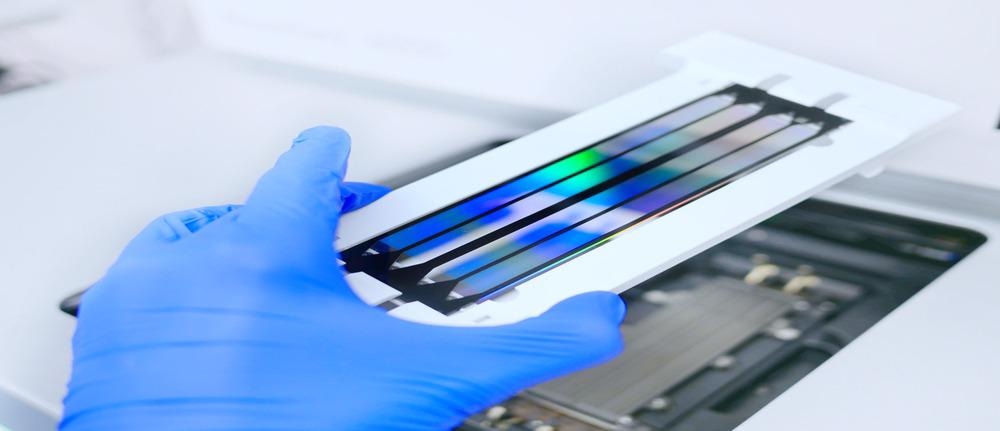Human identification is a critical component of forensics. Improvements in DNA sequencing have significantly reduced the associated costs due to the advent of Next Generation Sequencing (NGS). Whole Genome Sequencing is now achievable for less than a thousand dollars.

Image Credit: leolintang/Shutterstock.com
The gold standard for identification in forensics is “DNA fingerprinting”. Issues with contamination and DNA integrity during PCR amplification pose challenges. Improvements in NGS have allowed for improved enrichment of regions of interest. This technology has been applied to capture DNA in compromised samples. Alternatively, mitochondrial DNA can be used and can be easily sequenced.
Next-Generation Sequencing
Next-Generation Sequencing is a family of techniques that has accelerated the process of detecting nucleotides. Many of these are now commercially available and have significantly lowered the price of Whole Genome Sequencing. Most techniques rely on Sequencing by Synthesis. In this process, the genome is excised into small 100-200 base pair fragments via mechanical or enzymatic means.
The individual fragments can then be modified using RNA oligomers or adaptors (specific sequences that can be used as barcodes) via a ligation reaction. The fragments can then be immobilized to a solid surface or allowed to remain in solution. Critically, the fragments are hybridized to complementary sequences of known regions of interest (often called baits). The unbound DNA is removed, and the enriched DNA is eluted for NGS. Solution-based reactions often use baits with a moiety that can be used for purification.
Most commercial processes rely on some output from the nucleotide to detect it. Illumina utilizes modified nucleotides that can only be added one at a time, preventing the addition of the next nucleotide due to a blocking moiety. The different nucleotides contain fluorophores that can be distinguished by their different spectra. Following detection, the blocking moiety and fluorophore are excised, allowing for an extension. Other processes cannot differentiate between the nucleotides and instead will be exposed to a single nucleotide for a limited time.
Roche utilizes the by-product of the incorporation of the nucleotide, the pyrophosphate molecule. This reacts with firefly luciferase, which subsequently emits light corresponding to the number of nucleotides incorporated. Ion Torrent utilizes the pH change associated with nucleotide incorporation.
Human Identification Methods
Short Tandem Repeats (STRs) are short repeated sequences of DNA. The number of repeats varies between individuals, allowing for very high discrimination when used in combination. Thirteen STRs are used in forensics in the US under the Combined DNA Index System (CODIS). There are, however, issues with contamination and low copy number.
Analyzing trace amounts of DNA can pose challenges including amplification failure, bias towards shorter amplicons, and artifacts. Samples that are damaged chemically or thermally are more likely to experience lesions which also affect amplification. Heavily fragmented DNA can result in “jumping” PCR in which existing fragments can function as a template for the amplifying DNA due to the truncated nature of the initial fragment. These concerns undermine the efficacy of STR as a means of human identification, especially using ancient, poorly preserved samples.
Many improvements have been posited to curb these issues such as capillary electrophoresis, development of commercial STR kits, optimization of PCR conditions, and investigation into Single Nucleotide Polymorphisms (SNPs) as an alternative.

Image Credit: Elpisterra/Shutterstock.com
How can NGS be used in Human Identification?
An exciting alternative is mitochondrial DNA (mtDNA). Autosomal DNA is limited to two copies per cell while mitochondrial DNA copy numbers can be in the thousands. It can be obtained from bones, teeth, hair shafts, feces, and other biological materials. The maternal inheritance increases the breadth of reference samples.
Typically, detection of mitochondrial DNA focused on the hypervariable regions I and II. Much of the mitochondrial genetic variation exists outside this purview; the advancements in NGS facilitate rapid, accurate detection of the entire mitochondrial genome. This process has been successful in achieving this in samples that were too damaged to undergo STR profiling. This includes samples contaminated with microbial DNA and substances such as formaldehyde and humic acid.
Multiple rounds of enrichment were sufficient to obtain a full mitochondrial genome. This is particularly critical in samples with very low amounts of mtDNA as repeated enrichment serves to improve coverage. Very stringent controls were included in these studies to ensure that the mtDNA detected was not due to the operator or artefactual.
This process, while encouraging, fails to recapitulate the abundance of genetic information present in autosomal DNA. An alternative to improve coverage of autosomal DNA in contaminated samples is a technique called Whole-genome In-Solution Capture (WISC).
A modern human “bait” DNA library was developed. This was then transcribed into biotin-containing RNA baits. The fragmented DNA from the samples then hybridized to these baits. The hybridized samples were then pulled down using magnetic streptavidin beads, while the unbound DNA was washed away. Following this process, the number of reads corresponding to the human references increased significantly, the number of unique reads also increased significantly.
The use of the one thousand genomes as a reference played an important role in this process to ensure SNPs observed were due to genuine variation rather than nucleotide transitions. It allowed for the detection of these unique reads with low levels of sequencing, mitigating the necessity for repeated sequencing in heterogeneous samples. It also allowed for greater resolution of genetic variation observed between samples from similar geographical areas; traditionally this depended on haplotyping.
Conclusions
Identification of human remains is critical in archeology, anthropology, and forensics. DNA samples obtained at crime scenes and excavation sites are often in sub-optimal condition due to poor preservation or deliberate damage. DNA extracted from these samples is often contaminated with environmental DNA and chemical modifications, limiting its usefulness.
Improvements in NGS have generated thousands of intact genomes that can function as references. Methods adopted from NGS have been used to purify and enrich human DNA in compromised samples such as WISC. Whole mitochondrial sequencing can also provide an alternative with greater abundance and accessible profiling due to maternal inheritance.
Sources:
- Carpenter, M. L. et al. (2013) ‘Pulling out the 1%: Whole-Genome Capture for the Targeted Enrichment of Ancient DNA Sequencing Libraries’, The American Journal of Human Genetics, 93(5), pp. 852–864. doi: 10.1016/j.ajhg.2013.10.002.
- Gaudin, M. and Desnues, C. (2018) ‘Hybrid Capture-Based Next Generation Sequencing and Its Application to Human Infectious Diseases ’, Frontiers in Microbiology , p. 2924. Available at: https://www.frontiersin.org/article/10.3389/fmicb.2018.02924.
- Marshall, C. et al. (2017) ‘Performance evaluation of a mitogenome capture and Illumina sequencing protocol using non-probative, case-type skeletal samples: Implications for the use of a positive control in a next-generation sequencing procedure’, Forensic Science International: Genetics, 31, pp. 198–206. doi: https://doi.org/10.1016/j.fsigen.2017.09.001.
- McCombie, W. R., McPherson, J. D. and Mardis, E. R. (2019) ‘Next-Generation Sequencing Technologies’, Cold Spring Harbor perspectives in medicine, 9(11), p. a036798. doi: 10.1101/cshperspect.a036798.
- Templeton, J. E. L. et al. (2013) ‘DNA capture and next-generation sequencing can recover whole mitochondrial genomes from highly degraded samples for human identification’, Investigative Genetics, 4(1), p. 26. doi: 10.1186/2041-2223-4-26.
Further Reading